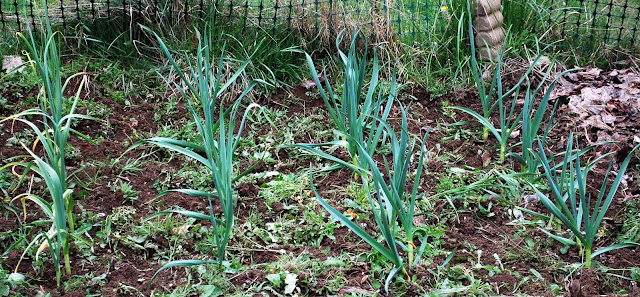 |
| Bearded Irises, No Mulch. 4.7.19 |
 |
| Bearded Irises, No Mulch. 4.7.19 |
I have decided that the recommendations to never mulch irises are so much garden legend, unfounded and contrary to fact. It could be, in most climates, and with most mulches, irises will get sick and die, like they suggest. Rhizomes rotting due to too much moisture.
A few years ago, I basically gave up on my irises. They repeatedly got fungal and/or bacterial leaf diseases. Not only misshapen and ugly, but the leaves would die at their bases.
I finally gave up, planted them at the edge of the woodlot, and mostly forgot about them. I mulched that area with arborist chips, to keep the weeds down. Interestingly, all of those irises flourished. And no leaf diseases. My enthusiasm returned, and I decided to move many of the clumps into a dedicated garden bed. I kept the soil surface clean, and free of weeds. I also added many new varieties. However, the space was limited, so probably half of my bearded irises are still in the mulched border.
Meanwhile, I added a finely chopped fir bark mulch to those in the border. This was the cheapest mulch I could find. I used it to keep down weeds.
 |
| Bearded Irises, Bark Mulch. 4.7.19 |
 |
| Bearded Irises, Bark Mulch. 4.7.19 |
Both groups of irises were doing great until this week. We had a chill, a big rain storm, and several rainy days.
Result: Now many of the irises that I am growing "correctly" have the leaf spot diseases again. None of the mulched ones do.
I'm disappointed. I really followed the instructions. But the ones that I had "written off" and mulched regardless of the MANY reports stating not to, look great. MANY of the ones that I treated right, with no mulch - have leaf spot diseases.
Here is my theory. Maybe the fir bark has antibacterial and antifungal properties. And maybe the rain splashes spores of bacteria and fungi onto the leaves, where they grow. Mulched soil does not allow the spread of the diseases.
As an aside, I had decomissioned some of the old raised iris beds and constructed a raised bud on top of them. I dug out most of the irises and moved the clumps to the woodlot border, but some were too much trouble. So I buried them, at least 6 inches deep. DUring the next year, several bearded iris plants grew up through the soil, and did fine.
 |
| Mearded Irises, Bark Mulch. 3.7.19 |
 |
| Bearded Irises, Bark Mulch. 3.7.19 |
I dug those out and moved them. They had constructed new, sort of vertical rhizomes, up to the soil surface. They are growing fine. So I'm really not convinved that the rule, never bury iris rhizomes, is universally true. Maybe mostly true, in most places. Garden wisdom happens for a reason. But I have to face the facts and experience in my garden: Not only does mulching, at least with shredded or small nougat fir bark, not damage iris rhizomes, it may well protect them from disease.
I'll continue to watch them, of course. Maybe the ones in the mulched borders are just waiting then will burst out with devastating leaf diseases. We'll see.








































 T
T








